Menu
-
- Home
-
About Us
-
The Approach
-
Linking Language & Literacy
-
MindWing Learning
-
Learning Resources
-
SHOP
-
Blog
-
- About MindWing
- Our People
- Contact Us
- Your Account
- Login
-
Spain (EUR €)

Read Across America Day & Dr. Seuss Lesson!
February 29, 2016 5 min read
 As always, I began writing my lesson by gathering my focus book and Story Grammar Marker® Mini-Posters. Since the children enjoyed our recent Rosa Parks read aloud Who was Rosa Parks? written by Yona Zeldis McDonough, this week I chose Who Was Dr. Seuss? written by Janet B. Pascal from the same series. I planned the lesson to coincide with Read Across America Day on March 2, which is Dr. Seuss’ birthday. The lexile measure of this book is 820L. The following lesson suggestions were designed for grades 3 and 4. Lessons may be modified to meet your student’s needs.
As always, I began writing my lesson by gathering my focus book and Story Grammar Marker® Mini-Posters. Since the children enjoyed our recent Rosa Parks read aloud Who was Rosa Parks? written by Yona Zeldis McDonough, this week I chose Who Was Dr. Seuss? written by Janet B. Pascal from the same series. I planned the lesson to coincide with Read Across America Day on March 2, which is Dr. Seuss’ birthday. The lexile measure of this book is 820L. The following lesson suggestions were designed for grades 3 and 4. Lessons may be modified to meet your student’s needs.
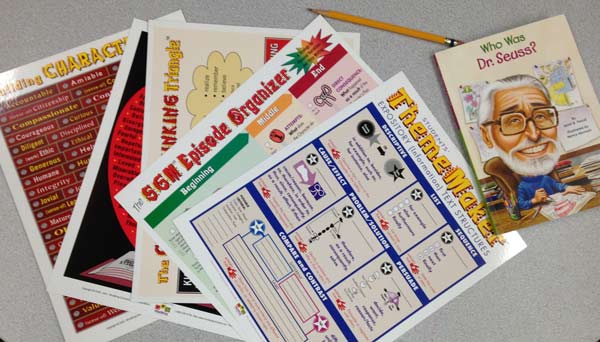
Many people ask how I go about creating lessons to use the SGM®. Really, it is the opposite thinking, as I always have asked myself: How can the SGM® be used to enhance the lessons I already do and target skills that I am trying to teach? Hopefully, the following series of four specific ways to approach this Dr. Seuss book and the related CCSS will demonstrate how to use this flexible SGM® methodology. Presenting this book as a read aloud would provide many opportunities for you to pull out specific parts of the text to teach/reinforce your learning objectives.
APPROACH #1
Integration of Knowledge and Ideas:
CCSS.ELA-LITERACY.RI.3.7
Use information gained from illustrations (e.g., maps, photographs) and the words in a text to demonstrate understanding of the text (e.g., where, when, why, and how key events occur).
CCSS.ELA-LITERACY.RI.3.8
Describe the logical connection between particular sentences and paragraphs in a text (e.g., comparison, cause/effect, first/second/third in a sequence).
Using SGM Universal Magnets (or if you have limited space, chart paper) and/or each student using copies of the Sequence Map from the ThemeMaker, keep track of the books that Dr. Seuss wrote as they are presented in Who Was Dr. Seuss?
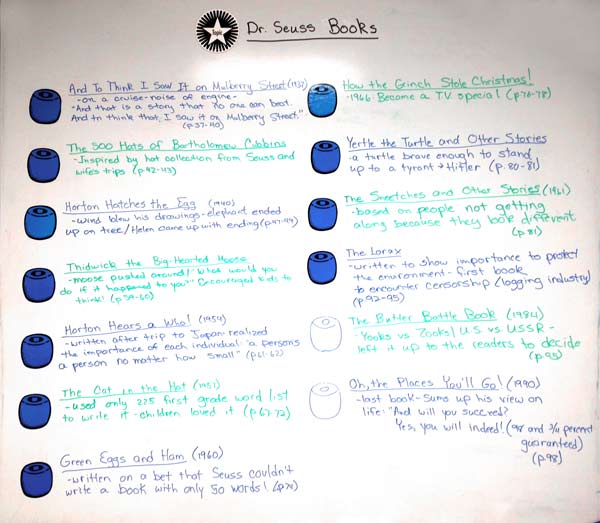
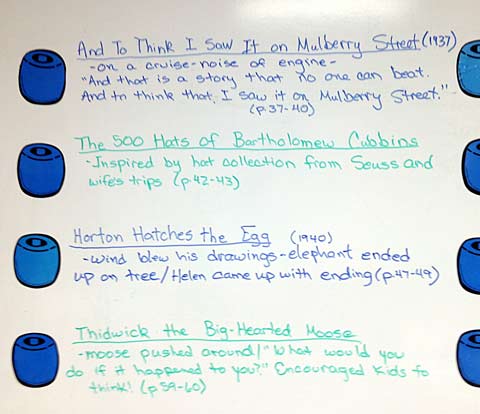 Note: We included the title of the book, the year it was written if it was presented in the biography, a fact (or two!) related to the book, and the page(s) where the information was obtained. This completed sequence of books written by Dr. Seuss would provide a valuable scaffold for students to share their knowledge in an oral presentation, having copies of each book from your school library to show along with the facts presented.
Note: We included the title of the book, the year it was written if it was presented in the biography, a fact (or two!) related to the book, and the page(s) where the information was obtained. This completed sequence of books written by Dr. Seuss would provide a valuable scaffold for students to share their knowledge in an oral presentation, having copies of each book from your school library to show along with the facts presented.
Presentation of Knowledge and Ideas:
CCSS.ELA-LITERACY.SL.3.4
Report on a topic or text, tell a story, or recount an experience with appropriate facts and relevant, descriptive details, speaking clearly at an understandable pace.
APPROACH #2
Key Ideas and Details:
CCSS.ELA-LITERACY.RI.4.2
Determine the main idea of a text and explain how it is supported by key details; summarize the text.
Next, I chose the Character Descriptive Map from the ThemeMaker® Manual to help categorize, keep track of, and summarize information about Dr. Seuss’ life presented in Who was Dr. Seuss? After reading several pages from the biography, I always stop and ask what we’ve learned about Dr. Seuss. This is a time to model that only the important facts will go on our Descriptive Map, since choosing which information to include is a skill that is difficult for most students. I have found it helpful to list all suggestions given by the students and then discuss which ones I would put on a map and why. Also, have students pair up with one another to read several pages, then ask them to discuss with their partner which facts would be included on the map. This is an ongoing skill that will be refined throughout one’s academic career!
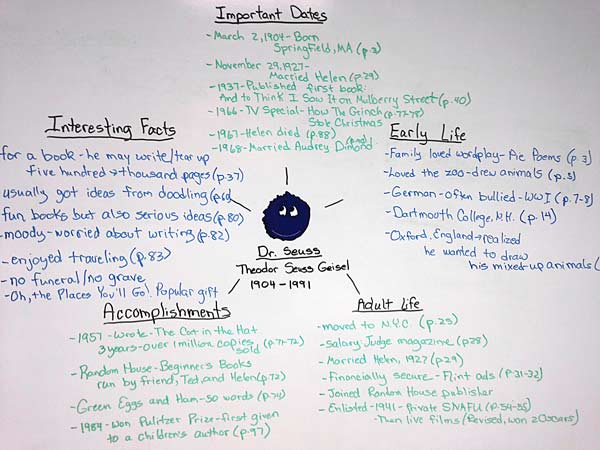
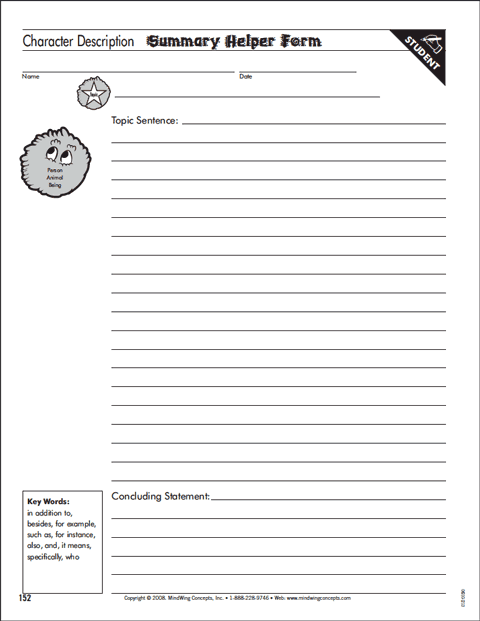 After using the completed map for students to share information orally, utilizing the Character Description Summary Helper Form would assist putting these facts into writing. Students could be assigned one category or multiple categories depending on skill levels.
After using the completed map for students to share information orally, utilizing the Character Description Summary Helper Form would assist putting these facts into writing. Students could be assigned one category or multiple categories depending on skill levels.
CCSS.ELA-LITERACY.W.4.2
Write informative/explanatory texts to examine a topic and convey ideas and information clearly.
CCSS.ELA-LITERACY.W.4.2.A
Introduce a topic clearly and group related information in paragraphs and sections; include formatting (e.g., headings), illustrations, and multimedia when useful to aiding comprehension.
APPROACH #3
There are several stories within this biography that could be used in mini-lessons to support skills in narrative retelling.
Presentation of Knowledge and Ideas:
CCSS.ELA-LITERACY.SL.4.4
Report on a topic or text, tell a story, or recount an experience in an organized manner, using appropriate facts and relevant, descriptive details to support main ideas or themes; speak clearly at an understandable pace.
Below find one example from pages 7-9 of Who Was Dr. Seuss? using our SGM® Mini-Magnets. It recounts a story of Ted getting ready to receive a Boy Scout award onstage, which was to be presented by former president Theodore Roosevelt. Due to an error and the fact that no adults spoke up, Ted did not receive the award and had to slink off stage. This created a lifelong fear of getting up in front of others. This episode could be mapped out with a small group of students and then they could retell the episode to one another or to the class using the SGM® Student Marker. This is a powerful activity to reinforce oral retellings. It could also be used to discuss the Critical Thinking Triangle® of not only how Ted must have felt, but how the students themselves would have felt with the same Kick-Off.
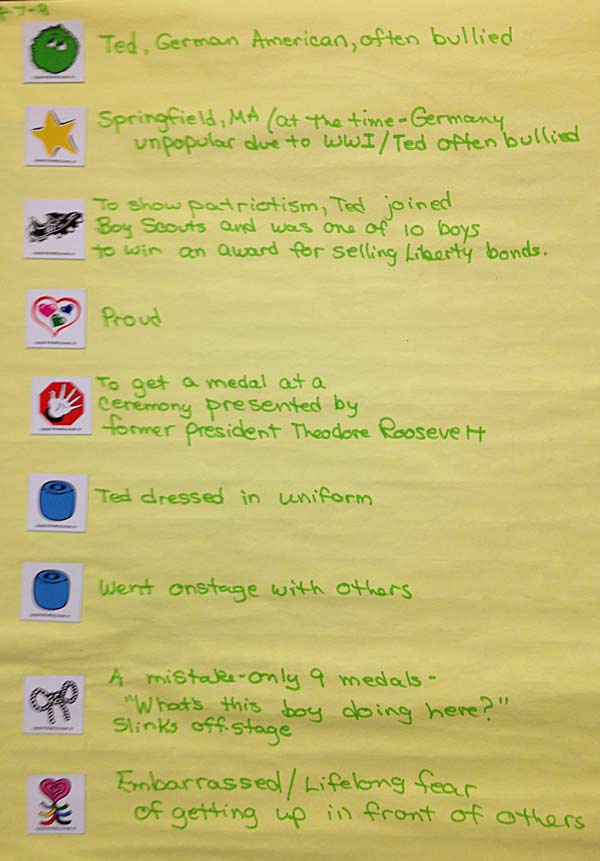
There are many other episodes that would lend themselves to a similar activity. Another episode I mapped out was from pages 67-72 regarding the writing of The Cat in the Hat, as this book is so well known and one that Dr. Seuss was most proud of.

APPROACH #4
The last lesson that I will share with you today is from pages 49-55. It brings in a series of cause/effect relationships surrounding the time period, how Dr. Seuss used his skills to influence others, and how he realized the importance of writing children’s books.
CCSS.ELA-LITERACY.RI.4.5
Describe the overall structure (e.g., chronology, comparison, cause/effect, problem/solution) of events, ideas, concepts, or information in a text or part of a text.
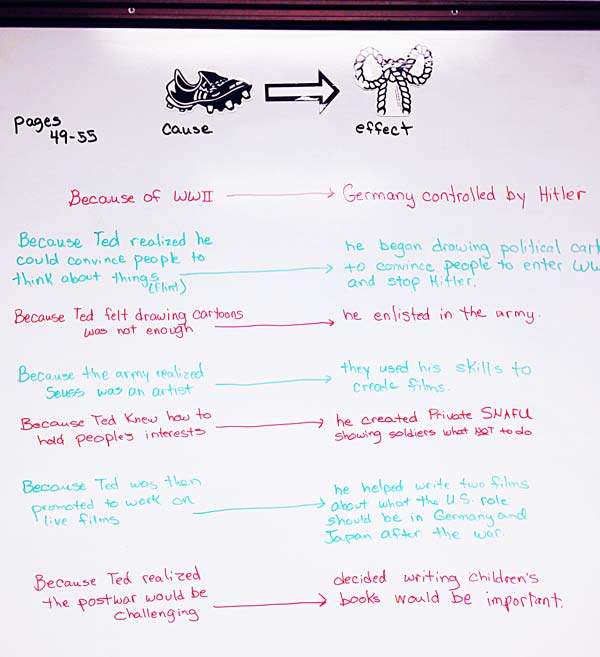
I started each “cause” with the cohesive tie word, because. However, you should be flexible and could choose any of the words presented on the Cause/Effect expository map. This could be a sentence combining activity to be used to differentiate instruction. For example: “The army realized Seuss was an artist so they used his skills to create films.”
CCSS.ELA-LITERACY.W.4.2.C
Link ideas within categories of information using words and phrases (e.g., another, for example, also, because).
Write informative/explanatory texts to examine a topic and convey ideas and information clearly.
I hope that these varied approaches give you some ideas to help bring the Story Grammar Marker® into your existing lessons. They may be used in isolation or in combination. The more you use the SGM® Narrative and Expository icons and maps, the more you will find how the methodology enhances children’s learning!
Leave a comment.
Comments will be approved before showing up.
